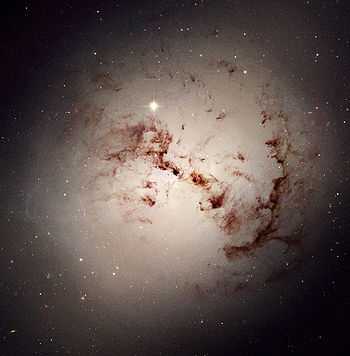NGC 1316
| NGC 1316 | |
|---|---|
 A Hubble Space Telescope (HST) image of NGC 1316. | |
| Observation data (J2000 epoch) | |
| Constellation | Fornax |
| Right ascension | 03h 22m 41.7s[1] |
| Declination | −37° 12′ 30″[1] |
| Redshift | 1760 ± 10 km/s[1] |
| Distance | 62.0 ± 2.9 Mly (19.0 ± 0.9 Mpc)[2][3][a] |
| Type | (R')SAB(s)00[1] |
| Apparent dimensions (V) | 12′.0 × 8′.5[1] |
| Apparent magnitude (V) | 9.4[1] |
| Notable features | Very bright at radio 1.4 GHz |
| Other designations | |
| Fornax A,[1] PGC 12651,[1] Arp 154[1] | |
| See also: Galaxy, List of galaxies | |
NGC 1316 (also known as Fornax A) is a lenticular galaxy about 70 million light-years away in the constellation Fornax. NGC 1316 is a radio galaxy. It is the fourth-brightest radio source in the sky (as seen at 1400 MHz).[4]
Structure and formation
François Schweizer studied NGC 1316 extensively in the late 1970s. He found that the galaxy appeared to look like a small elliptical galaxy with some unusual dust lanes embedded within a much larger envelope of stars. The outer envelope contained many ripples, loops, and arcs. He also identified the presence of a compact disk of gas near the center that appeared inclined relative to the stars and that appeared to rotate faster than the stars. Based on these results, Schweizer suggested that NGC 1316 was built up through the merger of several smaller galaxies. These merger events may have fueled the central supermassive black hole, that has a mass estimated in 130-150 million of solar masses[5] with gas, causing the galaxy to become a radio galaxy. He also states that NGC 1316 is comparable to the giant elliptical galaxies found in the centers of other clusters of galaxies.[4] Using spectroscopy of its brightest globular clusters, the merger is estimated to have occurred ~3 Gyr ago.[6]
It has been proposed too that NGC 1316 may be a galaxy in evolution that eventually will become a Sombrero-like system dominated by a large bulge[7]
Companions and environment
NGC 1316 is located within the Fornax Cluster, a cluster of galaxies in the constellation Fornax. However, in contrast to Messier 87, which is a similar elliptical galaxy that is located in the center of the Virgo Cluster, NGC 1316 is located at the edge of the Fornax Cluster.[8]
NGC 1316 appears to be interacting with NGC 1317, a small spiral galaxy to the north. However, that small spiral galaxy does not appear to be sufficiently large enough to cause the distortions seen in the structure of this galaxy.[4]
NGC 1316 was host to two well-observed type Ia supernova 1980N(Ia) and 1981D(Ia).[3]
Distance estimates
At least two methods have been used to estimate the distance to NGC 1316: surface brightness fluctuation (SBF) in 2003[2] and planetary nebula luminosity function (PNLF) in 2006.[3] Being a lenticular galaxy, it is not suitable to apply the cepheid variable method. Using SBF, a distance estimate of 20.0 ± 1.6 Mpc[2] was computed. Using PNLF, 45 planetary nebula candidates were located and a distance estimate of 17.9 +0.8
−0.9 Mpc was computed.[3] Averaged together, these two distance measurements give a combined distance estimate of 62.0 ± 2.9 Mly (19.0 ± 0.9 Mpc).[a]
See also
- Centaurus A - an elliptical/peculiar galaxy that is a strong source of radio emission
- Messier 87 - an elliptical galaxy at the center of the Virgo Cluster that contains relativistic jets originating from a supermassive central black hole
- NGC 1097 - a spiral galaxy with relativistic jets visible in optical light
Notes
- ^ average(20.0 ± 1.6, 17.9 +0.8
−0.9) = ((20.0 + 17.9) / 2) ± ((1.62 + 0.82)0.5 / 2) = 19.0 ± 0.9
References
- ↑ 1.0 1.1 1.2 1.3 1.4 1.5 1.6 1.7 1.8 "NASA/IPAC Extragalactic Database". Results for NGC 1316. Retrieved 2006-07-10.
- ↑ 2.0 2.1 2.2 Jensen, Joseph B.; Tonry, John L.; Barris, Brian J.; Thompson, Rodger I.; Liu, Michael C.; Rieke, Marcia J.; Ajhar, Edward A.; Blakeslee, John P. (February 2003). "Measuring Distances and Probing the Unresolved Stellar Populations of Galaxies Using Infrared Surface Brightness Fluctuations". Astrophysical Journal 583 (2): 712–726. arXiv:astro-ph/0210129. Bibcode:2003ApJ...583..712J. doi:10.1086/345430.
- ↑ 3.0 3.1 3.2 3.3 Feldmeier, John J.; Jacoby, George H.; Phillips, Mark M. (November 2006). "Calibrating Type Ia Supernovae using the Planetary Nebula Luminosity Function I. Initial Results". Eprint arXiv:astro-ph/0611231 657 (1): 76. arXiv:astro-ph/0611231. Bibcode:2006astro.ph.11231F. doi:10.1086/510897.
- ↑ 4.0 4.1 4.2 F. Schweizer (1980). "An Optical Study of the Giant Radio Galaxy NGC 1316 (Fornax A)". Astrophysical Journal 237: 303–318. Bibcode:1980ApJ...237..303S. doi:10.1086/157870.
- ↑ NOWAK N.; SAGLIA R.P.; THOMAS J.; BENDER R.; DAVIES R.I.; GEBHARDT K. (2008). "The supermassive black hole of Fornax A.". Monthly Notices of the Royal Astronomical Society 391. pp. 1629–1649.
- ↑ Goudfrooij, Paul; Alonso, M. Victoria; Maraston, Claudia; Minniti, Dante (November 2001). "The star cluster system of the 3-Gyr-old merger remnant NGC 1316: clues from optical and near-infrared photometry". Monthly Notices of the Royal Astronomical Society 328 (1): 237–256. arXiv:astro-ph/0107533. Bibcode:2001MNRAS.328..237G. doi:10.1046/j.1365-8711.2001.04860.x.
- ↑ McNeil-Moylan, E. K.; Freeman, K. C.; Arnaboldi, M.; Gerhard, O. E.. (2012). "Planetary nebula kinematics in NGC 1316: a young Sombrero". Astronomy & Astrophysics 539.
- ↑ H. C. Ferguson (1989). "Population studies in groups and clusters of galaxies. II - A catalog of galaxies in the central 3.5 deg of the Fornax Cluster". Astronomical Journal 98: 367–418. Bibcode:1989AJ.....98..367F. doi:10.1086/115152.
External links
Coordinates: ![]() 03h 22m 41.7s, −37° 12′ 30″
03h 22m 41.7s, −37° 12′ 30″